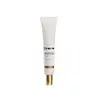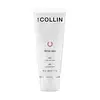What's inside
What's inside
 Key Ingredients
Key Ingredients

 Benefits
Benefits

 Concerns
Concerns

No concerns
 Ingredients Side-by-side
Ingredients Side-by-side

Water
Skin ConditioningSimmondsia Chinensis Seed Oil
EmollientC14-22 Alcohols
Emulsion Stabilising1,2-Hexanediol
Skin ConditioningDimethicone
EmollientPhenyl Trimethicone
Skin ConditioningGlycerin
HumectantArachidyl Alcohol
EmollientPolyacrylate-13
Cetearyl Olivate
Methyl Glucose Sesquistearate
EmollientButylene Glycol
HumectantHydrogenated Lecithin
EmulsifyingBehenyl Alcohol
EmollientSorbitan Olivate
EmulsifyingC12-20 Alkyl Glucoside
EmulsifyingTocopheryl Acetate
AntioxidantCaffeine
Skin ConditioningPolyisobutene
Arachidyl Glucoside
EmulsifyingCaprylic/Capric Triglyceride
MaskingCaprylyl Glycol
EmollientXanthan Gum
EmulsifyingScutellaria Baicalensis Root Extract
AstringentEthylhexylglycerin
Skin ConditioningPolysorbate 20
EmulsifyingHydrolyzed Collagen
EmollientGlyceryl Polyacrylate
Allantoin
Skin ConditioningSorbitan Isostearate
EmulsifyingAdenosine
Skin ConditioningCitrus Aurantium Dulcis Peel Oil
MaskingPhenoxyethanol
PreservativeSodium Hyaluronate
HumectantAcetyl Hexapeptide-8
HumectantPalmitoyl Tripeptide-1
Skin ConditioningPEG-40 Hydrogenated Castor Oil
EmulsifyingPPG-26-Buteth-26
Skin ConditioningCopper Tripeptide-1
Skin ConditioningWater, Simmondsia Chinensis Seed Oil, C14-22 Alcohols, 1,2-Hexanediol, Dimethicone, Phenyl Trimethicone, Glycerin, Arachidyl Alcohol, Polyacrylate-13, Cetearyl Olivate, Methyl Glucose Sesquistearate, Butylene Glycol, Hydrogenated Lecithin, Behenyl Alcohol, Sorbitan Olivate, C12-20 Alkyl Glucoside, Tocopheryl Acetate, Caffeine, Polyisobutene, Arachidyl Glucoside, Caprylic/Capric Triglyceride, Caprylyl Glycol, Xanthan Gum, Scutellaria Baicalensis Root Extract, Ethylhexylglycerin, Polysorbate 20, Hydrolyzed Collagen, Glyceryl Polyacrylate, Allantoin, Sorbitan Isostearate, Adenosine, Citrus Aurantium Dulcis Peel Oil, Phenoxyethanol, Sodium Hyaluronate, Acetyl Hexapeptide-8, Palmitoyl Tripeptide-1, PEG-40 Hydrogenated Castor Oil, PPG-26-Buteth-26, Copper Tripeptide-1
Water
Skin ConditioningGlycerin
HumectantCetearyl Isononanoate
EmollientIsohexadecane
EmollientPentylene Glycol
Skin ConditioningDicaprylyl Carbonate
EmollientKrameria Triandra Root Extract
Skin ConditioningArachidyl Alcohol
EmollientDimethicone
EmollientSimmondsia Chinensis Seed Oil
EmollientGlycine Soja Sterols
EmollientPanthenol
Skin ConditioningXylitylglucoside
HumectantAnhydroxylitol
HumectantAllantoin
Skin ConditioningSodium Hyaluronate
HumectantMadecassoside
AntioxidantAsparagopsis Armata Extract
Skin ProtectingXylitol
HumectantBiosaccharide Gum-2
Skin ConditioningBiosaccharide Gum-1
HumectantAscophyllum Nodosum Extract
Skin ConditioningGlucose
HumectantTripleurospermum Maritimum Extract
Skin ProtectingBoswellia Serrata Extract
Skin ConditioningHoney Extract
HumectantRosa Damascena Flower Extract
MaskingCamellia Sinensis Leaf Extract
AntimicrobialAspalathus Linearis Extract
Skin ConditioningTetrapeptide-14
Skin ConditioningChlorphenesin
AntimicrobialPhenoxyethanol
PreservativeHexamidine Diisethionate
EmollientSodium Benzoate
MaskingSorbic Acid
PreservativePotassium Sorbate
PreservativeTocopherol
AntioxidantSodium Dehydroacetate
PreservativeBehenyl Alcohol
EmollientHydrogenated Starch Hydrolysate
HumectantButylene Glycol
HumectantGlyceryl Stearate Se
EmulsifyingPEG-100 Stearate
Squalane
EmollientArachidyl Glucoside
EmulsifyingPolyacrylate-13
Carbomer
Emulsion StabilisingTriethanolamine
BufferingGlyceryl Polyacrylate
Polyisobutene
Disodium EDTA
Polysorbate 20
EmulsifyingSorbitan Isostearate
Emulsifying1,2-Hexanediol
Skin ConditioningCaprylyl Glycol
EmollientRicinoleth-40
CleansingUndecylenic Acid
CleansingWater, Glycerin, Cetearyl Isononanoate, Isohexadecane, Pentylene Glycol, Dicaprylyl Carbonate, Krameria Triandra Root Extract, Arachidyl Alcohol, Dimethicone, Simmondsia Chinensis Seed Oil, Glycine Soja Sterols, Panthenol, Xylitylglucoside, Anhydroxylitol, Allantoin, Sodium Hyaluronate, Madecassoside, Asparagopsis Armata Extract, Xylitol, Biosaccharide Gum-2, Biosaccharide Gum-1, Ascophyllum Nodosum Extract, Glucose, Tripleurospermum Maritimum Extract, Boswellia Serrata Extract, Honey Extract, Rosa Damascena Flower Extract, Camellia Sinensis Leaf Extract, Aspalathus Linearis Extract, Tetrapeptide-14, Chlorphenesin, Phenoxyethanol, Hexamidine Diisethionate, Sodium Benzoate, Sorbic Acid, Potassium Sorbate, Tocopherol, Sodium Dehydroacetate, Behenyl Alcohol, Hydrogenated Starch Hydrolysate, Butylene Glycol, Glyceryl Stearate Se, PEG-100 Stearate, Squalane, Arachidyl Glucoside, Polyacrylate-13, Carbomer, Triethanolamine, Glyceryl Polyacrylate, Polyisobutene, Disodium EDTA, Polysorbate 20, Sorbitan Isostearate, 1,2-Hexanediol, Caprylyl Glycol, Ricinoleth-40, Undecylenic Acid
Ingredients Explained
These ingredients are found in both products.
Ingredients higher up in an ingredient list are typically present in a larger amount.
1,2-Hexanediol is a synthetic liquid and another multi-functional powerhouse.
It is a:
- Humectant, drawing moisture into the skin
- Emollient, helping to soften skin
- Solvent, dispersing and stabilizing formulas
- Preservative booster, enhancing the antimicrobial activity of other preservatives
Allantoin is a soothing ingredient known for its protective and moisturizingg properties. Because of this, it is often added to products with strong active ingredients.
Studies show higher concentrations of this ingredient can promote wound healing.
Though it can be derived from the comfrey plant, allantoin is produced synthetically for cosmetic products to ensure purity.
Learn more about AllantoinArachidyl Alcohol is a fatty alcohol made from peanut oil. It is an emollient, emulsifier, and thickener.
You'll most likely find this ingredient as an emulsifier in water-based cosmetics.
We don't have a description for Arachidyl Glucoside yet.
Behenyl Alcohol is a type of fatty alcohol (these are different from the drying, solvent alcohols).
Fatty Alcohols have hydrating properties and are most often used as an emollient or to thicken a product. They are usually derived from natural fats and oils; behenyl alcohol is derived from the fats of vegetable oils.
Emollients help keep your skin soft and hydrated by creating a film that traps moisture in.
In 2000, Behenyl Alcohol was approved by the US as medicine to reduce the duration of cold sores.
Learn more about Behenyl AlcoholButylene Glycol (or BG) is used within cosmetic products for a few different reasons:
Overall, Butylene Glycol is a safe and well-rounded ingredient that works well with other ingredients.
Though this ingredient works well with most skin types, some people with sensitive skin may experience a reaction such as allergic rashes, closed comedones, or itchiness.
Learn more about Butylene GlycolCaprylyl Glycol is a humectant and emollient, meaning it attracts and preserves moisture.
It is a common ingredient in many products, especially those designed to hydrate skin. The primary benefits are retaining moisture, skin softening, and promoting a healthy skin barrier.
Though Caprylyl Glycol is an alcohol derived from fatty acids, it is not the kind that can dry out skin.
This ingredient is also used as a preservative to extend the life of products. It has slight antimicrobial properties.
Learn more about Caprylyl GlycolDimethicone is a type of synthetic silicone created from natural materials such as quartz.
What it does:
Dimethicone comes in different viscosities:
Depending on the viscosity, dimethicone has different properties.
Ingredients lists don't always show which type is used, so we recommend reaching out to the brand if you have questions about the viscosity.
This ingredient is unlikely to cause irritation because it does not get absorbed into skin. However, people with silicone allergies should be careful about using this ingredient.
Note: Dimethicone may contribute to pilling. This is because it is not oil or water soluble, so pilling may occur when layered with products. When mixed with heavy oils in a formula, the outcome is also quite greasy.
Learn more about DimethiconeGlycerin is already naturally found in your skin. It helps moisturize and protect your skin.
A study from 2016 found glycerin to be more effective as a humectant than AHAs and hyaluronic acid.
As a humectant, it helps the skin stay hydrated by pulling moisture to your skin. The low molecular weight of glycerin allows it to pull moisture into the deeper layers of your skin.
Hydrated skin improves your skin barrier; Your skin barrier helps protect against irritants and bacteria.
Glycerin has also been found to have antimicrobial and antiviral properties. Due to these properties, glycerin is often used in wound and burn treatments.
In cosmetics, glycerin is usually derived from plants such as soybean or palm. However, it can also be sourced from animals, such as tallow or animal fat.
This ingredient is organic, colorless, odorless, and non-toxic.
Glycerin is the name for this ingredient in American English. British English uses Glycerol/Glycerine.
Learn more about GlycerinWe don't have a description for Glyceryl Polyacrylate yet.
Phenoxyethanol is a preservative that has germicide, antimicrobial, and aromatic properties. Studies show that phenoxyethanol can prevent microbial growth. By itself, it has a scent that is similar to that of a rose.
It's often used in formulations along with Caprylyl Glycol to preserve the shelf life of products.
Polyacrylate-13 is a type of acrylate polymer. Acrylate polymers are commonly used as adhesives in cosmetics.
Polyacrylate-13 creates a film to protect the skin. It is also used to thicken and stabilize a product. It works by making water a gel-like consistency. This gel consistency helps suspend particles.
Polyacrylate-13 is a copolymer of acrylic acid, acrylamide, sodium acrylate, sodium acryloyldimethyltaurate monomers
Learn more about Polyacrylate-13Polyisobutene is a synthetic polymer made from isobutene.
It is a film-forming agent and helps bind ingredients together.
Polyisobutene is not absorbed by the skin.
Learn more about PolyisobutenePolysorbate 20 is made by combining ethoxylation of sorbitan, ethylene oxide, and lauric acid. It is a mild cleansing agent, surfactant, and emulsifier.
As a surfactant, it helps collect dirt and oils for washing. Emulsifiers prevent oils and water from separating.
Polysorbate 20 also adds scent to a product. Since it is made using sorbitol, it has a sweet scent. Sorbitol can also be found in fruits such as apples and peaches.
The lauric acid used to create Polysorbate 20 is often derived from coconuts.
Polysorbate 20 may not be fungal acne safe.
Learn more about Polysorbate 20This oil comes from the seeds of the desert shrub called Jojoba. It is more commonly known as jojoba oil, a non-comedogenic oil.
Jojoba oil does not contain fragrance and has many fatty-acids, making it a great soothing ingredient.
It also contains Vitamin E, a great moisturizing ingredient. Vitamin E is also an antioxidant and protects your skin against oxidative damage.
This ingredient humectant properties, meaning it helps draw moisture from the air. This helps keep your skin hydrated.
While jojoba has antibacterial properties, it is only able to kill some strains of bacteria.
Studies also show it helps in wound healing. In fact, Indigenous cultures have used jojoba as a moisturizer and to help treat burns for centuries.
Fun fact: Jojoba oil similar to natural human skin sebum, so it has a great effect on dry skin. It is also promising with helping to regulate sebum production.
Due to its fatty acid content, Jojoba oil may not be fungal acne safe. We recommend speaking with a professional if you have any concerns.
Learn more about Simmondsia Chinensis Seed OilSodium Hyaluronate is hyaluronic acid's salt form. It is commonly derived from the sodium salt of hyaluronic acid.
Like hyaluronic acid, it is great at holding water and acts as a humectant. This makes it a great skin hydrating ingredient.
Sodium Hyaluronate is naturally occurring in our bodies and is mostly found in eye fluid and joints.
These are some other common types of Hyaluronic Acid:
Learn more about Sodium HyaluronateSorbitan Isostearate is an emulsifer and cleaning agent. It is created from isostearic acid and sorbitol.
As an emulsifier, Sorbitan Isostearate prevents oils and water from separating.
Due to its isostearic acid base, it may not be safe for Malassezia or fungal acne.
Learn more about Sorbitan IsostearateWater. It's the most common cosmetic ingredient of all. You'll usually see it at the top of ingredient lists, meaning that it makes up the largest part of the product.
So why is it so popular? Water most often acts as a solvent - this means that it helps dissolve other ingredients into the formulation.
You'll also recognize water as that liquid we all need to stay alive. If you see this, drink a glass of water. Stay hydrated!
Learn more about Water